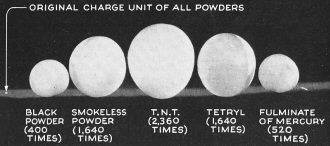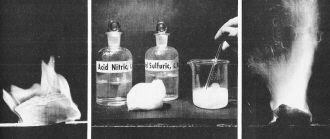Nitrogen Makes High Explosives for Modern War
|
|
In the early days of America's official involvement in World War II (we were unofficially involved in supplying equipment and strategy much earlier), much effort was expended in educating the public on the implements and tactics of war. Doing so help engaged citizens and give them a sense of involvement. Motivating young men (primarily) to volunteer to go far from home to fight an enemy in places most had never heard of before was a tall order. Sure, a forced conscription was implemented (the country's first peacetime draft beginning September 16, 1940), but patriotic volunteers are generally preferred for leadership and long-term commitment to achieving victory. That's not to say draftees were not likely to turn out being leaders and career men. Interestingly, so many American men were volunteering for duty that a presidential order was issued in December of 1942 banning volunteer service; the government would be the sole determiner of who would be in the service. ...but I digress. This "Nitrogen Makes High Explosives for Modern War" article appeared in the March 23, 1942 issue of Life magazine. Nitrogen Makes High Explosives for Modern War High-explosive 75-mm. round is loaded with seven charges of six different kinds of nitrogen explosives. Modern war is the product of the chemical reaction of explosion. In this process, a solid of comparatively small volume is translated in a fraction of a second into gases occupying a relatively huge volume. The 75-mm. shell and case diagramed above is a reaction chamber for a train of six different explosives. Their one common ingredient, and the one that makes them all explosive, is nitrogen, which is thus, far more than iron, the element that fights wars. Expansion Ratio, from solid to gas, of five nitrogen explosives in a 75-mm. round is indicated by balloons, with the dot at the left representing size of solid charge of each. Compounding of smokeless powder or nitrocellulose is demonstrated below. Tetryl and TNT are both coal-tar explosives. Variety of explosives insures safety and precision. Nitrogen, chief constituent of our atmosphere, makes its compounds explosive because it constantly seeks its state as a free gas. For this same reason, natural deposits of nitrogen compounds are rare. Until 1900, warfare was limited by the supply of naturally fixed nitrogen. Artificial nitrogen fixation (page 71) has since made war on its present scale possible. Modern war is given extra violence by toluol, made from coal tar and petroleum (bottles of clear fluid, opposite), which compounds with nitrogen into TNT. (L) Wad of cotton burns slowly -- (M) Cotton is nitrated and becomes nitrocellulose -- (R) Nitrocellulose is explosive
Posted February 21, 2022 |
|



